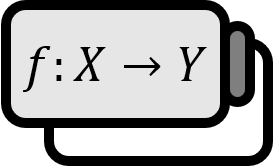Properties of the Dirac Delta Function
Properties
$$ \begin{equation} \delta (-x) =\delta (x) \end{equation} $$
$$ \begin{equation} \delta (kx)= \frac{1}{|k|} \delta (x) \end{equation} $$
Proof
Proof of $(1)$
Substituting $\int_{-\infty }^ { \infty } f(x) \delta (-x) dx$ with $-x \equiv y$ gets us $x=-y$ and $dx=-dy$,
$$ \begin{align*} \int_{-\infty } ^{ \infty } f(x) \delta (-x) dx =&\ -\int_{ \infty }^{-\infty} f(-y) \delta (y) dy \\ =&\ \int_{-\infty } ^{\infty } f(-y) \delta (y) dy \\ =&\ f(0) \\ =&\ \int_{-\infty } ^{\infty } f(x) \delta (x) dx \end{align*} $$
$$ \int_{-\infty }^ { \infty } f(x) {\color{blue}\delta (-x)} dx = \int_{-\infty } ^{\infty } f(x) {\color{blue}\delta (x)} dx $$
Therefore,
$$ \delta (-x) = \delta (x) $$
■
Proof of $(2)$
Substituting $\int_{-\infty }^ { \infty } f(x) \delta (kx) dx$ with $kx \equiv y$ gets us $x=\frac{1}{k}y$ and $ dx=\frac{1}{k}y$,
$$ \int_{-\infty }^ { \infty } f(x) \delta (kx) dx = \frac{1}{k} \int_{-\infty }^ { \infty } f(\frac{1}{k}y) \delta (y) dy $$
However, this result is under the condition $k>0$. When it’s $k<0$, the integration interval must be considered.
When it’s $k<0$ and substituting with $kx \equiv y$, it gets us $x=\frac{1}{k}y$, $dx=\frac{1}{k}y$ and hence $(x \rightarrow \infty \ ,\ y \rightarrow -\infty)$, $( x \rightarrow -\infty \ ,\ y \rightarrow \infty)$,
$$ \begin{align*} \int_{-\infty } ^{ \infty } f(x) \delta (kx) dx =&\ \frac{1}{k} \int_{\infty }^ { -\infty } f(\frac{1}{k}y) \delta (y) dy \\ =&\ \left( \frac{1}{-k} \right) \left(-\int_{\infty }^ { -\infty } f(\frac{1}{k}y) \delta (y) dy \right) \\ =&\ \frac{1}{|k|}\int_{-\infty }^ { \infty } f(\frac{1}{k}y) \delta (y) dy \end{align*} $$
Therefore, considering for all real numbers $k$,
$$ \begin{align*} \int_{-\infty }^ { \infty } f(x) \delta (kx) dx =&\ \frac{1}{|k|}\int_{-\infty }^ { \infty } f(\frac{1}{k}y) \delta (y) dy \\ =&\ \frac{1}{|k|} f(0) \\ =&\ \frac{1}{|k|}\int_{-\infty }^ { \infty } f(x) \delta (x) dx \\ =&\ \int_{-\infty }^ { \infty } f(x) \frac{1}{|k|}\delta (x) dx \end{align*} $$
$$ \int_{-\infty }^ { \infty } f(x) {\color{blue} \delta (kx)} dx=\int_{-\infty }^ { \infty } f(x) {\color{blue} \frac{1}{|k|}\delta (x) } dx $$
$$ \therefore \delta (kx) = \frac{1}{|k|}\delta (x) $$
■
